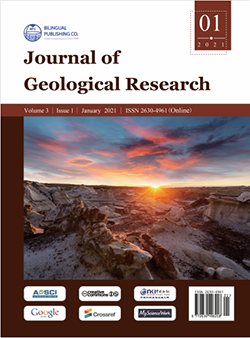Geostatistical Modelling of Reservoir Quality Over “Bright” Field,Niger Delta
DOI:
https://doi.org/10.30564/jgr.v3i1.2805Abstract
The quality of any hydrocarbon-bearing reservoir is vital for a successful exploitation work.. The reservoir quality is a function of its petrophysical parameters. Hence the need to model these properties geostatistically in order to determine the quality away from well locations.Composite logs for four wells and 3-D seismic data were used for the analysis. A reservoir named Sand X was mapped and correlated across wells 1 through 4. The four reservoir quality indicators - Effective porosity, permeability, volume of shale and net-to-gross- were estimated and modelled across the field.Sequential Gaussian simulation algorithm was employed to distribute these properties stochastically away from well locations and five realizations were generated. The volume of shale varied from 0.025 (Well 1, second realization) to 0.18(Well 2, first realization). The net-to-gross varied from 0.81 to 0.96 in wells 3 and 4 respectively, for the third realization, while the effective porosity varied from 0.125 to 0.295 for the fifth realization in Wells 3 and 4 respectively. The permeability is above 5000mD at all the existing well locations.These realizations were ranked using Lp norm statistical tool to pick the best for further evaluation. The reservoir quality deduced from the analyzed indicators was favourably high across the reservoir.The application of geostatistics has laterally enhanced the log data resolution away from established well locations.
Keywords:
Probabilistic; Lp norm; Modelling; Gaussian; StochasticReferences
[1] Kupecz, J.; Gluyas J., Block, S. Reservoir quality prediction in sandstones and carbonates: An Overview. In: Kupecz J., GluyasJ. and Block S. (Eds).Reservoir quality prediction in sandstones and carbonates, AAPG Memoir 69, 1997.
[2] Fanchi, J. R. Principles of Applied Reservoir Simulation. 2nd ed., MA, USA, Elsevier Burlington,2001.
[3] Bellman, R., Dreyfuss, S. Applied Dynamic Programming. Princeton, USA, Princeton University Press, 1962.
[4] International energy agency. World energy outlook,2007
[5] Love, K. M., Strohmenger, C., Woronow, A., Rockenbauch, K. Predicting Reservoir Quality Using Linear Regression Models and Neural Networks. 1997.
[6] Bloch, S. Empirical predictions of porosity and permeability in sandstones. AAPG Bulletin, 1991, 75:1145-1160.
[7] Nikravesh, M., Aminzadeh, F., Zadeh, L. A. Soft computing and intelligent data analysis in oil exploration. Ney York, USA, Elsevier, 2003.
[8] Ligtenbert, J. H., Wansink, A. G. Neural Network Prediction of permeability in the El Garia Formation,Ashtart Oilfield, Offshore Tunisia. In: Nikravesh M.,Aminzadeh F., Zadeh, L.A (Eds). Developments in Petroleum Science, 2003, 51: 397-411.
[9] Whiteman, A. Nigeria: Its petroleum geology, resources and potential: London. Graham and Trotman,1982; 381 .
[10] Reijers TJF. Selected Chapters on Geology, SPDC of Nigeria, Corporate Reprographic Services,Warri.,1996, 197.
[11] Short KC, Stauble, J. Outline geology of the Niger Delta. AAPG. 1967, Bull 5: 761-779
[12] Frankl, E.J., Cordy, E.A. The Niger Delta Oil Province Recent Development Onshore and Offshore,7thWorld Petroleum Congress Proceedings, Mexico City, IB, 1967: 195-209.
[13] Avbovbo, A. A., Tertiary lithostratigraphy of Niger Delta: American Association of Petroleum Geologists Bulletin, 1978, 62: 295-300.
[14] Adesida A, Ehirim, BO. Cenozoic Niger Delta: A guide to its lithosedimentary analysis. SPDC Exploration note 88.002 (Ref: on-shore wells), 1988, 1-10.
[15] Ejedawe, J.E., S.J.L.Coker, D.O. Lambert-Aikhionbare, K.B. Alofe, F.O. Adoh. Evolution of Oil Generating Window and Gas Occurrence in Tertiary Niger Delta Basin. AAPG Bull, 1984, 68:1744-1751.
[16] Deutsch, C.V. Geostatistical Reservoir Modeling.Oxford University Press, 2002: 376.
[17] Etu-Efeotor, J.O. Fundamentals of petroleum geology. Paragraphic publications, Port Harcourt, Nigeria, 1997, 135.
[18] Adeoti, L., Njoku, O., Olawale, O., Fatoba, J., Musa,B. Static Reservoir Modelling using Well Log and 3-D Seismic Data in a KN Field, Offshore Niger Delta, Nigeria. International Journal of Geoscience,2014, 5: 99-106.
Downloads
How to Cite
Issue
Article Type
License
Copyright © 2021 Abe, S.J, Olowokere, M. T, Enikanselu, P. A

This is an open access article under the Creative Commons Attribution-NonCommercial 4.0 International (CC BY-NC 4.0) License.
Copyright and Licensing
The authors shall retain the copyright of their work but allow the Publisher to publish, copy, distribute, and convey the work.
Journal of Geological Research publishes accepted manuscripts under Creative Commons Attribution-NonCommercial 4.0 International License (CC BY-NC 4.0). Authors who submit their papers for publication by Journal of Geological Research agree to have the CC BY-NC 4.0 license applied to their work, and that anyone is allowed to reuse the article or part of it free of charge for non-commercial use. As long as you follow the license terms and original source is properly cited, anyone may copy, redistribute the material in any medium or format, remix, transform, and build upon the material.
License Policy for Reuse of Third-Party Materials
If a manuscript submitted to the journal contains the materials which are held in copyright by a third-party, authors are responsible for obtaining permissions from the copyright holder to reuse or republish any previously published figures, illustrations, charts, tables, photographs, and text excerpts, etc. When submitting a manuscript, official written proof of permission must be provided and clearly stated in the cover letter.
The editorial office of the journal has the right to reject/retract articles that reuse third-party materials without permission.
Journal Policies on Data Sharing
We encourage authors to share articles published in our journal to other data platforms, but only if it is noted that it has been published in this journal.




 Abe, S. J
Abe, S. J

